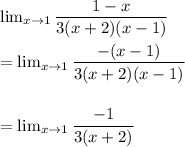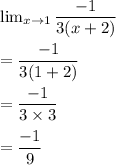Answer:
Hence, the limit of the expression:
 is:
is:

Explanation:
We are asked to estimate the limit of the expression:

We will simplify the expression by first taking the l.c.m of the terms in the numerator to obtain the expression as:


since the same term in the numerator and denominator are cancelled out.
Now the limit of the function exist as the denominator is not equal to zero when x→1.
Hence,

Hence, the limit of the expression:
 is:
is:
